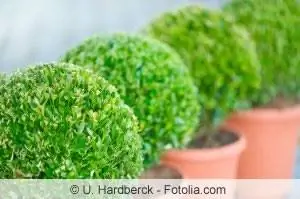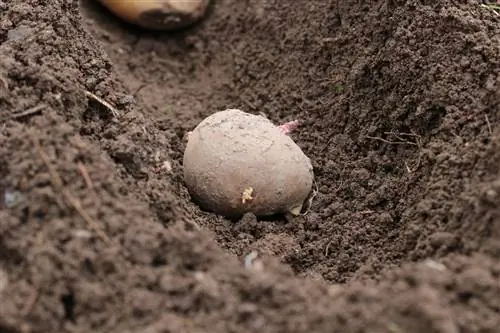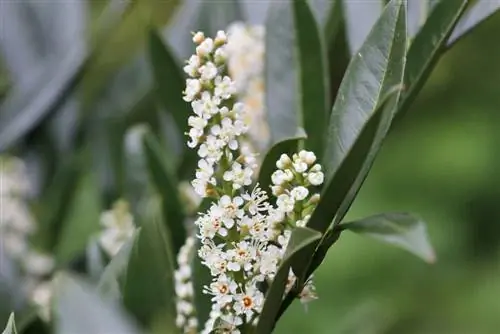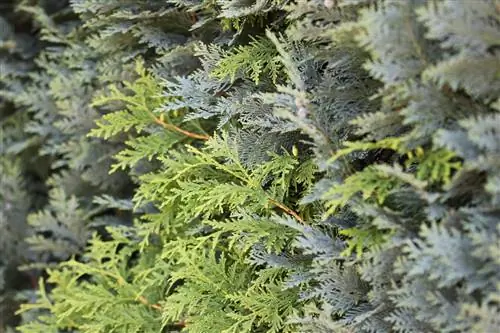- Author admin [email protected].
- Public 2023-12-17 03:39.
- Last modified 2025-01-24 12:45.
With boxwood, creative gardeners create fantastic garden sculptures, shapely balls and cones or elegant hedges. In order for the creative staging of the evergreen shrub to be successful, the focus is on more sober aspects, such as professional planting. The following instructions show the workflow in detail, including precise information regarding timing and planting distance. Useful tips with hand and foot round off the reading material.
The best time
The quality of the root packaging defines the ideal date to plant a boxwood. This is accompanied by more flexible handling of the planting time, which is particularly suitable for hobby gardeners who have a lot of time constraints.
- Boxwood grown in a pot or container can be planted all year round, as long as it doesn't freeze
- The time window for planting bale goods is open from October to May
- Naked boxwood wants to go into the ground from October to November or February to April
- Sun-warm, autumnal soil provides the boxwood with ideal conditions for rapid growth until the first frost. The ornamental shrub will then start the new growing season next year with a considerable growth lead.
Planting instructions
Regardless of the nature of the root packaging, the actual planting workflow follows a largely uniform procedure. The following instructions explicitly point out specific special features.
Location
Native to the warm regions of southern Europe, boxwood thrives more vitally the closer the site conditions are to the conditions there.
- Sunny to partially shaded, warm location
- Air-surrounded so that raindrops dry quickly
- Ideally pampered by the morning or evening sun

A boxwood does not want to be confronted with shady lighting conditions, nor does it want to be confronted with accumulated heat in front of the south wall of the house. Although the robust ornamental tree will not give up straight away, it will still show rather poor growth under such strenuous conditions.
Soil and substrate
A key pillar in the successful cultivation of boxwood is the composition of soil and substrate. At this point the desire for balance comes to light; a character trait that is outstanding for boxwood in every respect. This is what the potting soil should be like:
- Deep, nutritious soil, rich in humus
- Well drained and at the same time fresh and moist
- Moderately calcareous with a pH value of 7 to 8
- In the pot, preferably a nutrient-rich, structurally stable substrate
As a shallow rooter, boxwood depends on well-ventilated soil. The Mediterranean shrub will not be able to cope with compaction or even waterlogging. Its roots would suffocate miserably. If in doubt, soil additives should be used, such as sifted compost, fine-grained sand or lava granules in the planter.
Plants
Before planting, the root area of boxwood is soaked with water in a container for several hours. Meanwhile, prepare the soil at your chosen location by thoroughly weeding and removing stones or roots. If the boxwood finds a fine, crumbly soil, it will be all the more happy to stretch out its roots. Follow these steps to continue planting:
- Create a planting pit with a circumference 15-20 cm larger than the root ball
- Enrich the excavation with compost, granulated cattle manure or similar organic fertilizer
- Unpot container goods and insert in the middle
- Place the baled goods together with the bale cloth in the ground, only then open and bury them
- Remove kinks and breaks on bare-root boxwood and shorten the roots to 25-30 cm
Insert the boxwood so deeply that the root neck is covered with soil at least 5 centimeters high. Tamp the soil firmly and water generously. A mulch layer of leaves, bark mulch or compost creates a beneficial microclimate in the soil.

If you plant Buxus in a pot, the procedure is similar. Drainage over the water drain in the ground is particularly important here to prevent waterlogging. To do this, use a coarse, inorganic material such as grit, gravel or pottery shards. Insert a water- and air-permeable fleece between the drainage and the substrate.
Tip:
Since baled goods and bare-root goods lose root mass during clearing, experienced hobby gardeners cut back the boxwood by a third. This measure restores the balance between roots and shoots.
Planting spacing
So that the planting of boxwoods is completely satisfactory, the planting distance plays an important role. This is especially true when aiming for an accurate or opaque hedge. Given the slow growth, a good sense of proportion is required here so that unsightly gaps do not remain for several years. At the same time, the shallow-rooted plant's competitive weakness against stronger plant neighbors must be taken into account. The precise planting distance depends on the variety planted. You can plant the two most popular varieties as a hedge at this planting distance:
- Buxus sempervirens suffruticosa, the ideal, small bed border: 20 cm (8-10 plants per linear meter)
- Buxus sempervirens arborescens for privacy hedges: 30-35 cm (2-3 plants per linear meter)
For a solitary plant, however, larger distances are recommended so that there is no competition from roots.
Care tips
In order for boxwood care to work, you have to pay attention to a few things when caring for it.
Watering and fertilizing
A balanced water and nutrient balance strengthens the vitality of a boxwood throughout the seasons. The ornamental tree has a lush green, dense habit and proves to be resistant to diseases and pests. The following aspects of care are of particular relevance:
- Keep the substrate constantly moist without causing waterlogging
- The water requirement is always higher in the bucket than in the bed
- Administer a special slow-release fertilizer for boxwood in April and June
- Alternatively, work organic fertilizer into the soil every 2 weeks
- In addition to compost, chicken and mushroom manure as well as vermicompost are suitable
Mineral fertilizer must not be applied to dry substrate. Under no circumstances should the preparation come into contact with the leaves because it causes burns.
Cutting
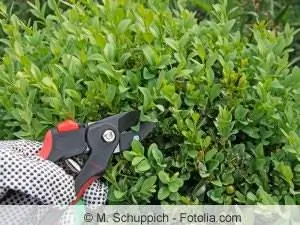
To keep a boxwood in its beautiful shape, it is cut once or twice a year. Knowledgeable hobby gardeners carry out the first cut in May, followed by another cut in August or September. From October onwards, Buxus should no longer be cut. How to do it right:
- Basically cut on a dry, overcast day
- The scissors are freshly sharpened and disinfected
- Cut carefully and more often than the other way around
- The first cut in May is carried out in conjunction with thorough thinning
- The cut always runs from top to bottom
If you moisten the boxwood before starting work, the stress is reduced for both the gardener and the tree. Spread an old curtain under the plant to catch the clippings. This caution makes later clean-up work easier. Whenever you cut, remember that a boxwood can only gradually close any gaps due to its slow growth. If you have an artistic design in mind, a variety of stencils from specialist retailers serve as excellent working aids. To ensure that a hedge cut runs as straight as possible, simply stretch several cords between two wooden posts for orientation.
Important:
Wear gloves during all planting and care work, because boxwood is poisonous in all parts.
Conclusion
Evergreen boxwood inspires the imagination and realizes many a design wish in the ornamental garden. Whether as a shapely sphere, an accurate cuboid or an artistic sculpture; With Buxus your garden will always be on trend. To ensure that it stays that way for many years, professional planting at the best time and at the right planting distance plays a crucial role. The plan can only succeed if the creative ideas can be reconciled with the gardening requirements. These instructions with practical tips for care set the course for success in the hobby garden.

